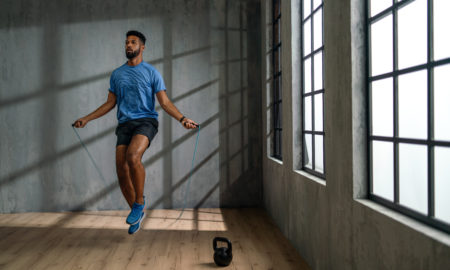Continuing from Part 1 with my account of getting back on my training track after sustaining an injury:
December 1993: I started treating my lower-back problem with trigger-point therapy the first week, when I was 35 years old. Although I bought special tools, I realized in hindsight that I could have used a tennis ball and a golf ball. For example, I could have held a tennis ball against a wall and leaned against it to apply the required pressure against the trigger points in my upper-back and shoulder regions. For my lower back and hips I could have lain supine on the floor and put a ball between the floor and the trigger point I wanted to treat. My weight alone, along with some slight movement to and fro on the ball, would have supplied the required pressure to the trigger points.
I was loaded with trigger points in an arc around my lower-back and upper-buttocks area, especially the latter. Tackling the trigger points on a regular basis in my glutes was what made the most impact in controlling pain in my lower back. The glutes can take a lot of pressure during trigger-point therapy. Like the trigger points I had in abundance in my upper back, thighs and shoulders—especially the right shoulder—the ones in my lower back and buttocks were almost painful to touch.
There was immediate improvement in my lower back from the trigger-point therapy, and after a few weeks I knew for certain that I’d struck gold for my lower-back problems. The sciatica in my left leg was much reduced too. Further, at about that time I noticed that my knees suffered much less crackling and grittiness.
I was conscientious with the trigger-point therapy despite working 80 or more hours a week. I missed only a handful of days of therapy over the first three months.
January 1994: A month later my right shoulder seemed to be at 100 percent, and I could add that to the complete success I had with the toe injury—plus my knees continued to improve. By late January my lower back felt nearly 100 percent most days and a full 100 percent on some days.
In January I noticed that it was harder to find trigger points in all my former troubled areas because I was no longer loaded with them. Maintenance trigger-point work for my right shoulder needed much less time than did the initial daily work I’d done to fix the problem.
I was now starting to feel youthful, which gave me relative freedom to move around without having to watch out for this or that movement that used to bother me. It was a new lease on life.
For the previous 18 months my knees would ache if I stood for more than half an hour or so. In January 1994, however, my knees didn’t bother me even if I stood for long periods, and my “moviegoer’s knees” were long gone. (Even from before the peak of the deadlift cycle in 1992 I had “moviegoer’s knees,” a condition that makes keeping knees bent at a right angle uncomfortable, which makes sitting in a movie house difficult unless you can keep your legs out nearly straight in the aisle.)
April 1994: Now I was able to train normally. Considering that I’d been recently disabled by several injuries, my progress from the trigger-point therapy was almost miraculous.
I had made sufficient progress, without surgery, to know that the orthopedic surgeon’s summer 1993 diagnosis of chondromalacia patellae and the need to “take it easy” had been way off the mark. That man and probably many others like him casually prescribe surgical measures that in many cases are not only unnecessary but over the long term may make matters worse.
Don’t agree to any orthopedic surgery—unless it’s reconstruction work following a serious accident—until you’ve first thoroughly investigated noninvasive alternatives.
The appropriate treatment at the right time can mean the difference between needing a week off training or perhaps years off. When you sustain an injury, seek expert noninvasive therapy immediately, and you may hugely hasten recovery time.
A devastating aspect of the 1992 injuries was that they forced me to stop serious weight training for a long period. As a result I lost a great deal of muscle and strength. I became detrained, which made the problems worse. Had I known about trigger-point therapy in July 1992, I might never have had to lay off from training for more than a week or so after peaking at 400×20 in the deadlift.
Completing the comeback. In 1996 I returned to the strength level and development I’d had in early summer 1992, just prior to the injuries that stymied me. What a traumatic four years it had been. It was desperately frustrating on the one hand but enormously instructive on the other.
Next month I’ll teach you how to perform trigger-point therapy on yourself.
—Stuart McRobert
www.Hardgainer.com
Editor’s note: Stuart McRobert’s first byline in IRON MAN appeared in 1981. He’s the author of the new 638-page opus on bodybuilding Build Muscle, Lose Fat, Look Great, available from Home Gym Warehouse, (800) 447-0008, or www.Home-Gym.com.




















You must be logged in to post a comment Login